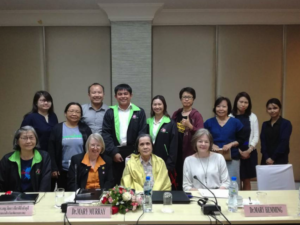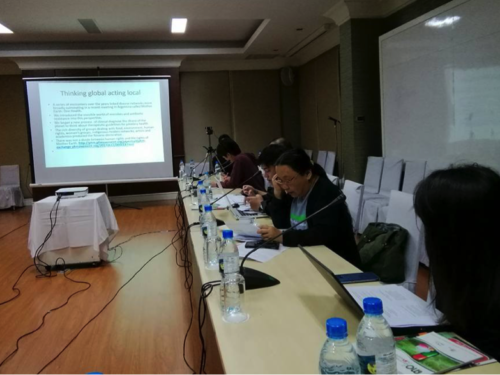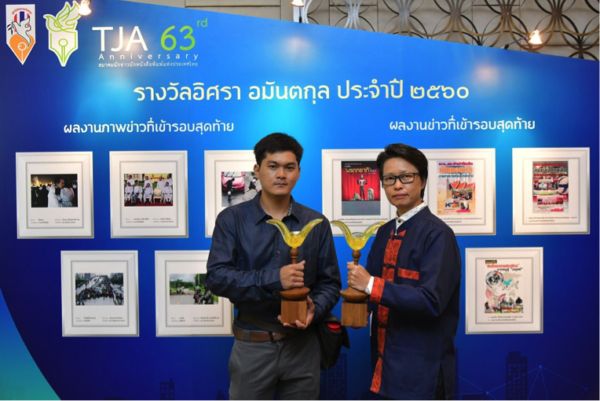New Approaches of Analysis and Synthesis for Better Understanding on Medicines and Society
The Director of the Drug System Monitoring and Development Centre (DMDC), Chulalongkorn University, and board member of the International Society to Improve the Use of Medicines (ISIUM), Dr. Niyada Kiatying-Angsulee organised a meeting to introduce ISIUM to Thai colleagues working  in the field of rational use of medicines (RUM) and antimicrobial resistance, to share experience and explore what new ways might be needed for work to improve the use of medicines.
in the field of rational use of medicines (RUM) and antimicrobial resistance, to share experience and explore what new ways might be needed for work to improve the use of medicines.
The meeting took place on December 14, 2017, SaSa House, Chulalongkorn University, Bangkok, Thailand.
About 15 people participated as well as ISIUM representatives Mary Murray, Mary Hemming and Dr. Niyada. Thai colleagues came from a wide range of backgrounds including hospital pharmacy, the social pharmacy department of Chulalongkorn University, an anthropologist working on the project Antimicrobial Resistance in Society, engineers working on the environmental aspects of antimicrobial resistance, co-founder of the Sustainable Alternative Development Association, and a media representative amongst others.
The discussion centred around the need to revitalise efforts to improve the use of medicines given the changes in the world since the RUM movement began, why ISIUM was formed, reviewing the framework for RUM and ways of working towards it, the process of developing independent user friendly therapeutic guidelines and a societal, ecological approach to responding to antimicrobial resistance.
Introducing ISIUM: Finding new concepts and ways to work towards better understanding and use of medicines in society
Mary Murray presented the aims and structure of ISIUM and why it was established. She reflected on some of the achievements of the medicines movement including fundamental Concepts such as Health for All and the Essential Medicines Concepts in the 70’s, the Rational Use of Medicines concept (Nairobi) 1985, the Comprehensive Drug Policy concept (90’s) and the concepts of Drug policy within Health Policy and Health in all Policy. Many organisations and networks have developed to work on specific challenges such as access to medicines in stronger health systems including promotion of Universal Health Coverage.
There has been much experience with and innovation in methods and tools, and expertise gained in implementing these. There is more awareness about medicines issues in health professional, policy and systems development and good implementation in a number of settings. Achievements have been hard won in the face of industry and commercial opposing pressures.
However, there are few ongoing meeting places for people to link and share work, tools or innovations in the field of improving the use of medicines. It is hard to find information on interventions/strategies that have worked no matter what level and setting. There is insufficient focus and involvement of lay people in RUM work. Awareness of medicines issues is not strong amongst non-health professionals. It appears to many that the RUM movement would benefit from new energy and ways of working.
The landscape is changing. The culture of medicines in society is increasingly shaped by the market, by promise of hope for cure and a long comfortable life. The expectations around medicines in general and new targeted therapies will increase inequity and costs of healthcare. A technical way of working is insufficient to influence this culture. We need to get better at working in the social, bio-cultural space. Problems as complex as antibiotic resistance mean we need to relate our work to broader contexts such as the environment/ ecosystem and understand the impacts on medicines by factors other than health. Antibiotic resistance is a good example of how we need to transform historically linear approaches into ways of thinking and working within complex adaptive systems. For medicines in general we need to think more ecologically and develop effective and useful methods, tools and interventions collaboratively with people living within diverse, local contexts without mainstream resources and systems.
ISIUM is committed to establishing three core functions:
- A platform to connect people and share information on any activities relating to improving the use of medicines by gathering information from members to create databases of members and their networks, their interests and activities in improving the use of medicines; and links to, independent and trusted sources of information about medicines and their use.
- A think tank to analyse controversial issues relating to the use of medicines in society that have been identified by any process within ISIUM, to develop and publish articles that translate the complex issues behind the science and use of medicines for various audiences, particularly lay people and regulators, and to identify and stimulate discussion on other critical and pertinent issues such as the limits of knowledge of medicines, the processes used to create evidence, issues surrounding conflicts of interests in the marketing and regulation of medicines in society.
- An open forum to invite enquiry into aspects of medicines in society to support the needs of people, looking critically at what we do not know including previously unconsidered perspectives, to develop new paradigms, and to reveal and give expression to views of medicines outside conventional approaches.
Dr Niyada was pleased to note that DMDC was ISIUM’s first formal collaborator. The group expressed interest in working with ISIUM through the DMDC.
Therapeutic Guidelines: An Australian Initiative
Mary Hemming presented the rationale and process of creating therapeutic guidelines in Australia that work from users points of view. She painted the picture of 1970’s Melbourne where there was some general interest in better use of medicine but no formalized focus for it. Following an outbreak of antibiotic resistant infections in one of the major teaching hospitals, a process began to develop guidelines in such a form that was really convenient and helpful to doctors in their fast clinical decision-making.
These initiatives eventually morphed into the establishment of Therapeutic Guidelines Limited (TGL) which is a not-for-profit company, financially self supporting, and intellectually and financially independent of government and pharmaceutical industry. Its objective is to produce, publish and sell products to promote the quality use of medicines. Its core activity is to produce comprehensive, up-to-date, disease-based guidelines for therapy based on the best available evidence integrated with clinical experience.
Mary (Hemming) explained the difference between the traditional starting point for guidelines and the TGL approach which starts with clinical problems for which prescribers needs answers rather than starting with the evidence. It addresses issues that are actually faced by clinicians not those thought to be important by others, such as fund-holders. It arranges the flow of information to fit in with the clinical workflow and it tries to answer all questions.
She explained the process of development – using antibiotic guidelines as an example – and she demonstrated how in every step, the usability for general practitioners and hospital doctors is built into the substance and presentation of the guidelines. The writing groups contain experts and user representatives. The guidelines have proved very popular with clinicians to the extent that sales to doctors and others enable the company to remain self-supporting financially, and independent. Evaluation shows that the guidelines are used as:
- A problem-based look-up for general practitioners, junior doctors, pharmacists, nurses and students;
- As a basis for teaching in medical, pharmacy and dentistry schools;
- As criteria for clinical audits and evaluation;
- As a basis for local development of policies and protocols within healthcare institutions and decision support systems; and
- Antibiotic guidelines are linked to national standards, antimicrobial stewardship and hospital accreditation.
Mary Hemming explained that TGL had recently set up a foundation, the Therapeutic Guidelines Foundation. A major focus of this Foundation is to support and offer training in guideline methodology to people from other countries.
Medicines and Antibiotic Resistance as if Mother Earth Mattered
Mary Murray presented the perspective and work of ReAct Latin America and the Global Reimagining Resistance Group to bring an ecological perspective to the problem of antibiotic resistance through understanding the workings of the microbial world for health and life. The premise is that by appreciating the fundamental importance of microbes in the processes of health of all species, the nature and impact of antibiotics and how microbes react to them becomes easier to understand.
Moving away from the war metaphor as a way to relate to the microbial world has been important since the new discoveries at the cutting edge of microbiology. Quoting Nobel Prize winner in Medicine, Joshua Lederberg, she argued for the need to challenge ourselves to think ecologically and put a personal and community value on ecosystems.
‘Perhaps one of the most important changes we can make is to supersede the 20th-century metaphor of war for describing the relationship between people and infectious agents. A more ecologically informed metaphor, which includes the germs’-eye view of infection, might be more fruitful.’ [1]
She explained how the work of ReAct Latin America and the Reimagining Resistance Group has worked in a trans-disciplinary way bringing artists, scientist, social activists, health professionals, thinkers and community organisers together in a rich unfolding dialogue from which education programs have emerged, arts-medicine collaborations, indigenous and agro-ecological initiatives to make the microbial world more visible and relate it practically to traditional and modern knowledge of ecosystems and ways to live in harmony with the earth.
Using the child-to-child methodology, a project called Alfoja Educativa: Educational Backpack on School Health and the Microbial World was developed after early dialogue with children about microbes showed how fast they are to change their perceptions of the microbial world from monsters to companions.[2]
Story telling has been an important process because it amplifies the understanding and spread of knowledge within peoples own language and experience. Writing competitions sought stories from people’s own experience or good writing about the theme by young writers. (Bac Historias).
In launching a series of publications, (Microbes and Metaphors, Reimagining Resistance) different people, scientists, artists, writers, philosophers were asked to write and reflect on the publications. These were published as a further publication called ‘Amplifying and Embellishing the Mosaic.[3]
Building on this work over 10 years, the two groups, inspired by the Antibiotic Smart Use program in Thailand, and early discussions about creating Antibiotic Twin Cities, are now developing a concept for Antibiotic Smart cities, towns or communities where we see the whole at local levels. How urban life is connected to rural life, though basic functions in the production and travel of food, water, soil, animals, people and plants, municipal and health services, homes and schools. By making the passage of antibiotics and resistant genes more visible in local ecosystems and municipal life, the imperatives for more restrained use of antibiotics become clearer.[4]
Lively discussion followed about antimicrobial resistance and the challenge of communicating what it is and the broad scope of its causes and impact. The journalist present agreed that was very hard to understand and explain to people. Mattana from Sustainable Alternative Development Association reflected that there needs to be a sustained level of awareness raising like was done in Thailand for AIDS. In that case, it had been important to shock people. However creative advertisers had also been very important – so we need involve the people who are good at communication. It is also important to mobilise contract farmers in the campaign.
Research on wastewater from pig farms has shown the presence of antibiotics in Thailand. MCR-1 a gene conferring resistance to colistin has been found in pigs and capable of horizontal transfer into humans. Much concern was expressed in the discussion about the distribution of antibiotics and how to get into the mindset of the policy maker to get real action on this.
The discussion came back to the conundrum of using fear messages too much in the case of antibiotic resistance as people already have a deep-seated fear of microbes in general, and fear messages reinforce the war metaphor shaping human relations with the microbial world. An ecological approach means the messaging needs to be nuanced and provide real understanding of the dynamics of the microbial world and the movement of resistant genes in the environment in response to modern use of antibiotics.
The project leader of the Antimicrobial Resistance in Society project in Thailand described how they are studying one area in Northern Thailand following the activities of the many diverse groups there: refugees, organic farmers, tourism to the organic farms, conventional agriculture growing crops and pig and chicken farming, as well as doctors and pharmacists and other groups comprising the community.
Their methodology is a ‘following’ approach – following things and knowledge.
- Antibiotic logistics: Where do the ingredients come from? How are they distributed into the country? The project is following the knowledge from professors to lay people.
- Different perceptions of different generations of doctors; how is knowledge distributed to laypersons and communities for example in social media.
- The policy process: global to national to local; how the WHO antimicrobial resistance plan can flow in Thailand; how used in communities.
- Microbes: follow the social lives of microbes; with people, soil, water and with in the human body; not so much following pathogens but the microbiome.
Proposal for Debates: New faces of rational use of medicines
Dr. Niyada presented her ideas for exploring new faces of RUM, looking back at the key landmarks of the RUM movement since in 1980s. She gave a brief synopsis of RUM in the WHO regime including the WHO definition of RUM:
RUM requires that ‘patients receive medications appropriate to their clinical needs, in doses that meet their own individual requirements, for an adequate period of time, and at the lowest cost to them and their community’.
WHO advocates the following 12 key interventions that to promote rational use:
- Establishment of a multidisciplinary body to coordinate policies on medicines use
- Use of clinical guidelines
- Development and use of national essential medicines list
- Establishment of drug and therapeutic committees in districts and hospitals
- Inclusion of problem-based pharmacotherapy training in undergraduate curricula
- Continuing in-service medical education as a licensure requirement
- Supervision, audit and feedback
- Use of independent information on medicines
- Public education about medicines
- Avoidance of perverse financial incentives
- Use of appropriate and enforced regulation
- Sufficient government expenditure to ensure availability of medicines and staff.
The WHO focus on rational use since the Alma Ata Declaration has risen and fallen with major agenda setting efforts in the form of Resolutions, situation reports and operational research in the 80s, 90s and first decade of this century. It is now rather quiet on the WHO front in regard to RUM.
The Thai experience started in 1981 with a National Drug Policy of limited scope with no follow up action. It was updated in 1993 with a stronger strategy but weak implementation. A major revision was undertaken in 2011 with extensive preparation and good participation from many sectors. Since 2017, there is a major priority to expand and implement this policy and integrate it in to the health system. Antimicrobial resistance is a key focus. The chair of the RDU committee plans for Thailand to be proclaimed an RDU country.
Dr. Niyada presented key points from a literature search of the last 5 years on RUM noting that information existed on patterns of use of medicines in various illnesses, patterns of use of various medicines, factors affecting behaviour, publications of KAP of professionals, consumers and the media and a number of issue- based publications on things such as off-label use, injection use and vaccines.
Taking antimicrobial resistance as an example of explaining RUM in different ways, she stressed new contexts for working on RUM as a whole such as taking a holistic/One Health approach; understanding more about the body-microbe-environment interaction; thinking more broadly about food as medicines, the role of microbes in body well-being; the politics in moving antimicrobial resistance onto the action agenda; and developing an agenda for more vaccines and mew medicines.
Her thoughts about the new faces of RUM, and where new understanding is needed, cover the following:
- How do people explain or describe RUM? Including patient experiences, cultural sensitivities and socio-behavioural aspects.
- Internalising understanding by professionals about people’s behaviours, knowledge etc and by people themselves.
- Interesting issue to explore might include: politics-pharmacopolitics and geopolitics as they relate to health and medicines; an ecosystem for RUM; internalization and deeper understanding about RUM and society; RUM with specific themes such as humanitarian/disaster sector, access to medicine etc.
- Developing some innovative methods to develop information/evidence more relevant to ordinary people in their diverse contexts.
A wide-ranging lively discussion followed. The need to think about the environmental aspects of medicines was one theme emerging with a serious discussion about the challenge of learning to think in terms of complex adaptive systems ways particularly for antimicrobial resistance but also for medicines in general.

The group reviewed the framework for developing policy and practices to address antimicrobial resistance and RUM in Thailand to critically think about its adequacy in terms of consumers and the community.
The engineers, their first time participating in such a meeting, talked about the challenge in water management to manage chemical pollution and antibiotic resistance.
It was a stimulating enjoyable meeting, bringing back energy to the RUM/ISIUM challenge. It was videoed on and transmitted through Facebook live to the followers of the DMDC network.

Following the meeting the journalist present, Punnee Amornviputpanich (pictured right) wrote an investigative piece about the MCR-1 gene following the illegal use of colistin in pig farming in Thailand which won the Best News Report for one of the most prestigious journalism prizes in Thailand, and drew a sharp warning to farmers from the Livestock Development Department of Thailand.[5]
[1] Lederberg, J. (2000). Infectious history. Science. 2000;288:287–293. doi: 10.1126/science.288.5464.287
[2] http://www.react-latinoamerica.org/index.php?option=com_content&view=article&id=11&Itemid=129
[3] http://www.react-latinoamerica.org/index.php?option=com_content&view=article&id=11&Itemid=129
[4] The RLA website http://www.react-latinoamerica.org/ has information in Spanish and English.
[5] http://www.nationmultimedia.com/detail/national/30340245
